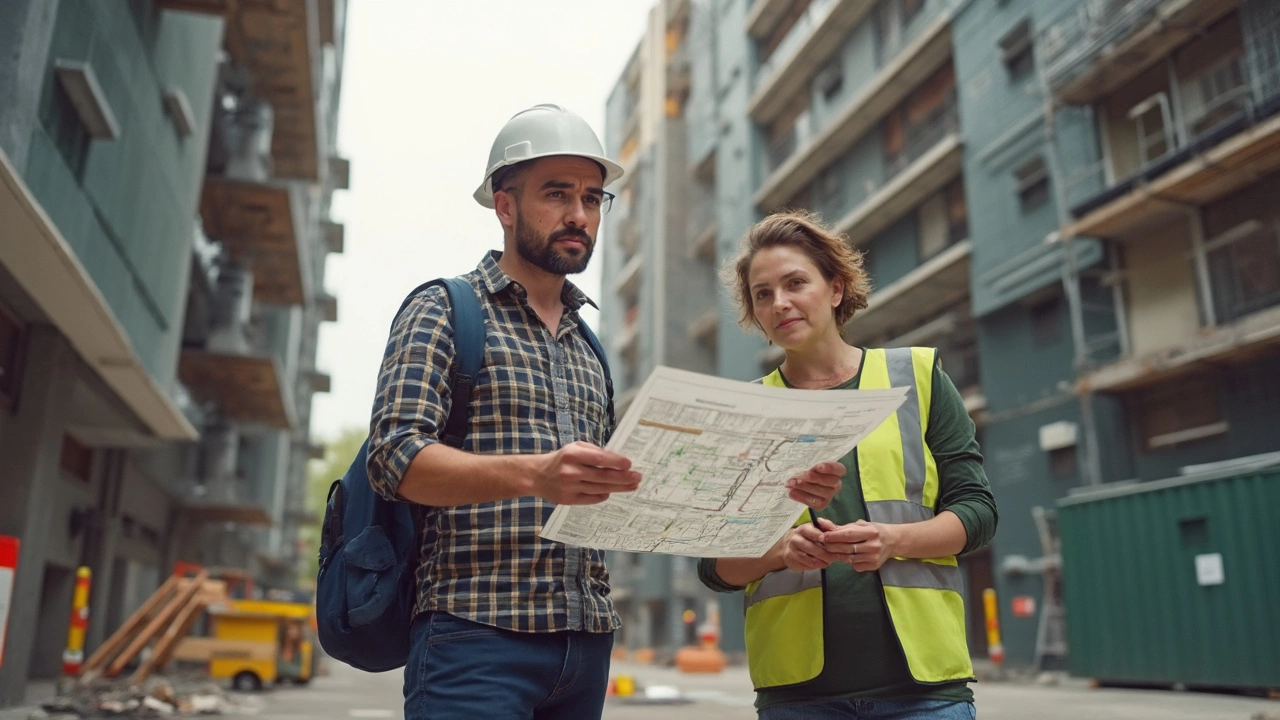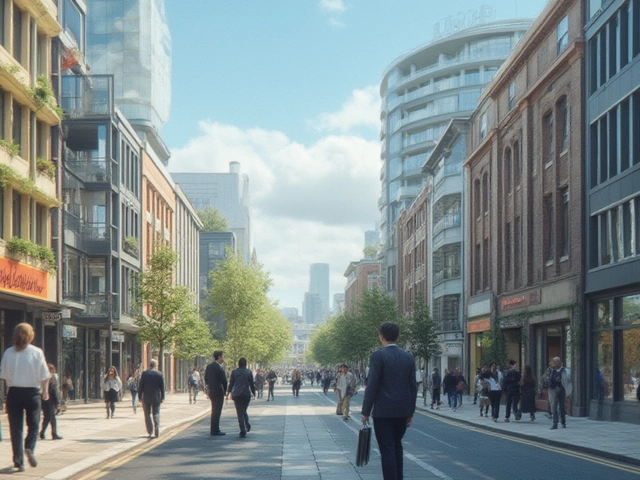What separates a commercial building from every other structure on your city block? It’s not just about the number of floors or how shiny the windows look. The real difference comes down to the purpose: commercial buildings are made for business, not for living in.
If you’ve ever leased an office, walked into a mall, or visited your local pharmacy, you’ve already set foot in a commercial space. These buildings are designed from the ground up for business use, whether that’s selling shoes, serving coffee, or housing a corporate team.
One wild fact? Some grocery stores and gyms can legally be counted as "mixed-use" because cities sometimes want business and homes in the same footprint. Rules and definitions vary, so the label “commercial” isn’t just a guess—it’s baked into local zoning codes and regulations.
Choosing the right kind of building matters for everything from taxes and fire codes to parking. If you’re thinking about opening a business or investing, understanding what makes a building commercial saves you from surprise headaches later on.
- Defining Commercial Buildings
- Key Features of Commercial Properties
- Common Types of Commercial Buildings
- Zoning Laws and Regulations
- Spotting the Differences: Residential vs. Commercial
- Tips for Evaluating Commercial Spaces
Defining Commercial Buildings
So, what exactly turns a structure into a commercial building? It's all about how you use the space. In the construction world, if a building is mostly used for business, selling something, or providing services to non-residents, it's commercial. That includes everything from high-rise office towers to small family-run restaurants.
There's a big difference between someone living in a house and a company running its daily operations in a workspace. In fact, zoning laws usually separate buildings into categories: residential, industrial, and—yep—commercial. You can't just open a bakery in your living room and call it a commercial space, no matter how good your cookies are.
Here are some key things that define a commercial building:
- It's designed and built for business activities like sales, services, or offices.
- It's often regulated under different safety, accessibility, and building codes than houses.
- It can cover places like banks, hotels, gyms, retail stores, warehouses, and clinics.
The United States’ official property codes, and most city ordinances, list entire sets of rules that only apply to commercial construction. For example, exits requirements are stricter, access for people with disabilities is mandatory, and insurance policies are usually more complex and expensive.
Here’s a good example: A building used for a dentist’s office falls under "commercial". Same building—if it’s remodeled into apartments—it instantly shifts to "residential." The main thing regulators and inspectors check is what the space is actually being used for on a day-to-day basis.
Curious about how commercial properties stack up? Here’s a quick table breaking out some real-life uses and how they’re classified:
| Building Type | Main Use | Classification |
|---|---|---|
| Retail Store | Selling goods | Commercial |
| Apartment Building | Living units | Residential |
| Warehouse | Storing inventory | Commercial |
| Home with Home Office | Living, with small workspace | Usually Residential |
| Medical Clinic | Health services | Commercial |
The bottom line? If you’re using a building to make money and serve customers or clients who don’t live there, odds are you’re dealing with a commercial property.
Key Features of Commercial Properties
Not every building filled with offices or storefronts checks all the boxes for a commercial building. There are some standard features that set these places apart from residential or industrial properties. Let’s break down what truly makes a property commercial.
Commercial buildings have these common features:
- Business Usage: The main thing? They’re built for making money—think shops, restaurants, factories, or offices. If the building’s primary activity is business or trading, it’s commercial.
- Public Access: Most commercial properties are places where customers, clients, or employees come and go daily. From department stores to dental clinics, the public interacts with these spaces.
- Specialized Construction: You’ll see everything from reinforced floors in warehouses to advanced air conditioning in data centers. Commercial construction usually needs bigger elevators, larger rooms, industrial kitchens, or wide hallways to handle crowds and equipment.
- Zoning and Compliance: Local governments control what happens inside city lines. A commercial building has to follow strict rules for fire safety, parking, accessibility, and signage. These rules are usually tougher than residential codes.
- Utility Demands: These buildings pretty much guzzle electricity and water compared to a house. More lighting, tons of computers, industrial-sized appliances, and bathroom facilities for big groups are common.
- Lease Structures: Rent for business space works differently from apartments. Commercial leases go longer, often have more legal requirements, and can let renters modify the space for their business needs.
How big can a commercial building get? There’s no strict rule, but retail stores in the U.S. average around 19,000 square feet, while small shopfronts can be less than 2,000 square feet. That’s a huge range.
| Feature | Commercial Building | Residential Building |
|---|---|---|
| Primary Use | Business/Trade | Living |
| Design | Large rooms, flexible layouts | Bedrooms, smaller kitchens |
| Regulations | Strict (fire, ADA, signage) | Standard |
| Typical Lease | 3-10 years, modified by tenants | 12 months, minimal mods |
When you see those big parking lots, loading docks, or huge signs out front, you’re usually looking at a commercial property. Every one of those details is designed to keep businesses running smoothly and people coming through the door.
Common Types of Commercial Buildings
Walk down any busy street and you'll spot different flavors of commercial buildings everywhere. Each type has its own layout, code rules, and purpose. Let’s break down the big categories so you can spot them in the wild.
- Office Buildings: These range from humble coworking spaces and dentist offices to huge downtown skyscrapers. A full 60% of U.S. office buildings are found in suburban areas, not city centers. Layouts can be open for startups or cut into private offices for law and accounting firms.
- Retail Stores: This category pulls in everything from fast food drive-thrus to sprawling shopping malls and local strip centers. Grocery stores, clothing outlets, hair salons—all fit here. One thing they have in common: clear setups for customer traffic and lots of parking nearby.
- Industrial Buildings: These buildings are all about storing, producing, or shipping things. Think warehouses, distribution centers, and light manufacturing plants. Most of Amazon’s fulfillment centers fall into this category, often covering hundreds of thousands of square feet.'
- Hotels: Short-term lodging grabs its own category. Decades ago it was all about basic motels, but today, hotels come in every style, from budget chains to luxury towers with conference centers and restaurants inside.
- Medical Facilities: Hospitals, urgent care clinics, and medical offices round out the list. Unlike regular offices, these require special codes for things like airflow, privacy, and safety equipment.
- Special Purpose Properties: Ever noticed a bowling alley, car wash, or self-storage place? These don’t fit the usual molds, but they’re 100% commercial buildings designed for specific tasks.
If you’re curious what the breakdown looks like nationwide, here’s a quick snapshot based on data from the U.S. Energy Information Administration's 2018 Commercial Buildings Energy Consumption Survey:
| Type | Share of Commercial Floor Space (%) |
|---|---|
| Office | 17% |
| Mercantile/Retail | 16% |
| Warehouse & Storage | 14% |
| Service (salons, laundromats, etc.) | 9% |
| Education | 13% |
| Healthcare | 8% |
| Other | 23% |
So if you’re scoping out commercial construction options, keep these categories in mind. Your business idea should match the space—no one wants to serve coffee in a warehouse meant for forklifts.

Zoning Laws and Regulations
Before any commercial building goes up or gets reworked, the number one thing you’ve got to check is the zoning. Zoning laws tell you what can and can’t be built on a piece of land, and what kind of business can actually run there. Every city has a zoning map and code, and jumping the gun without checking can shut your project down fast.
For example, you can’t just build a car repair shop anywhere you like. It has to fit into a zone approved for that type of commercial construction. Same goes for restaurants, retail stores, offices, or warehouses. Even tiny home-based businesses face different zoning expectations than big shopping centers.
Here’s a quick breakdown of what zoning laws usually cover for commercial building projects:
- Permitted Uses — Lists what kinds of businesses are allowed in a certain area. Some spots are retail-only, others are mixed-use, and some are just for industrial work.
- Building Size & Height — Rules over how tall a building can be or how much space you’re allowed to cover on the land.
- Packing & Parking — Decides how many parking spots you need for your business and where delivery vehicles can access the property.
- Signage — Even your business sign is regulated: how big, what type, and where it can be put up.
- Setbacks — These are minimum distances between your building and the property lines or streets. No hugging the sidewalk unless the code says it’s okay.
- Accessibility Requirements — ADA rules apply, which means commercial spaces have to be accessible for everyone by law.
Want an eye-opener? Some U.S. cities dedicate over 40% of their land area to commercial and industrial zoning. That means a massive chunk of your neighborhood might be business-only, no homes allowed.
If your business needs something special, you’re not out of luck. Cities allow for rezoning, variances, or special permits—though you’ll need to go through a public request process and sometimes face neighbors who aren’t thrilled about a new nightclub next door.
The bottom line: You can dream up any commercial building you want, but zoning laws are the gatekeepers that decide what’s allowed. Always talk to the local planning office before making big commercial moves.
Spotting the Differences: Residential vs. Commercial
Ever walk down a street and wonder why one building is an apartment and the one next to it is a clinic or retail shop? Turns out, it’s all about how they’re set up and what they’re meant for. Commercial buildings serve businesses—think banks, restaurants, gyms, or office spaces. Meanwhile, residential buildings are built for folks to live in, like houses, condos, or apartment towers. But there’s more to it than just who hangs out inside.
Here’s where you really see the split:
- Design and Infrastructure: Commercial buildings need things like fire suppression systems, elevators built for higher foot traffic, loading docks, or bigger parking lots. Residential spots focus on cozy layouts, quiet hallways, and bedrooms, not boardrooms.
- Zoning and Codes: Cities split up land by how it can be used. If the land is zoned "commercial," you’re allowed to run businesses there. "Residential" zoning is for homes only. If you try to mix them up without the right permits, you’re in for a load of trouble—think fines or being forced to move.
- Financing and Insurance: Buying a commercial property? Banks treat you differently. Commercial loans have higher interest rates and shorter terms. Insurance coverage also costs more since business activity can mean more risks.
- Utilities and Maintenance: Expect higher energy bills in commercial spaces. HVAC, security systems, and lighting all get a boost to handle crowds or equipment. For residential, everything is streamlined for lower personal use.
Check out this quick comparison to see the nuts and bolts:
| Feature | Residential | Commercial |
|---|---|---|
| Main Use | Living | Business/Services |
| Zoning | Residential only | Commercial/mixed |
| Building Codes | Standard safety | Stricter, fire & ADA |
| Financing | Lower interest, longer term | Higher rates, shorter term |
| Parking | Usually 1-2 spots/unit | Large lots or structured |
If you’re eyeing a spot for your next venture or trying to buy a place to live, don’t skip this difference. Messing it up can get costly fast, and might even get your business shut down. Remember: if folks live in it, it’s probably residential. If it generates income, brings in customers, and follows stricter safety measures, it’s commercial.
Tips for Evaluating Commercial Spaces
Looking at commercial buildings isn’t just about picking what looks coolest or newest. It’s about finding a space that fits your business needs right now—and down the road. Before signing any lease or dropping money on a property, you’ll want to dig into the basics and some not-so-obvious details.
- Location is king: Ask anyone in commercial construction, and they’ll stress this again and again. A killer location drives foot traffic and makes it easy for your clients, customers, and team to get in and out. Check traffic patterns, parking availability, and walkability. If you’re aiming for foot traffic, being near popular stores or public transit can make or break your sales.
- Building condition: Old electricals or leaky roofs can turn your dream space into a headache. Always inspect the age of major systems—HVAC, plumbing, elevators—because replacements aren’t cheap. Even in a new-looking space, hidden issues can be expensive. According to a 2023 CBRE report, maintenance costs for outdated systems can eat up to 15% more of your yearly expenses.
- Zoning and permits: Sounds boring, but if you want to open a restaurant and the building’s only zoned for retail, you’ll run into a wall. Always confirm what’s actually allowed in your commercial building before betting your business on it. City planners can be strict—even minor changes like signage or outdoor seating can need approval.
- Accessibility: Under U.S. law, most commercial spaces must follow ADA guidelines, which means having ramps, accessible restrooms, and sometimes elevators. Ignoring this can lead to fines or lawsuits, not to mention shrinking your customer base.
- Flexibility of layout: Businesses grow and change. Choose a space that can adjust with you—think open spaces that can be walled off, or offices with windows and good lighting. Skipping this can box you in both literally and financially, especially if you decide to expand.
Here’s a quick look at features business owners commonly say matter most when choosing commercial buildings:
| Factor | Percentage who rated it 'Very Important' |
|---|---|
| Location/Visibility | 78% |
| Building Condition | 62% |
| Zoning/Regulations | 55% |
| Lease Flexibility | 44% |
| Parking | 41% |
One last tip: when looking at a commercial building, ask for utility bills and maintenance records. Landlords with nothing to hide will have no problem sharing these. If they’re cagey, consider it a red flag. Smart choices here save you headaches, money, and maybe even your business’s future.





